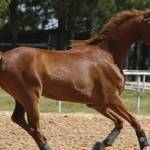Body Condition of Sport Horses

The sport in which horses participate often dictates the body condition in which they are maintained. Polo ponies are typically sleek and trim their fitness, evident in a tight, tucked-up appearance. The same can be said of most racehorses. Pleasure horses, those mounts used to poke around trails and forests, are sometimes softer and less muscular, carrying more body fat. Sport horses frequently fall somewhere between the two extremes. Equine nutritionists and researchers are uncovering interesting trends related to body condition and metabolic conditions, some of which directly relate to whether certain sport horses are as susceptible to metabolic conditions as horses that are exercised from time to time or not at all.
The scientists at Kentucky Equine Research teamed up with Olivia Martin of Performance Feeding to quantify the body condition of horses and ponies representing several disciplines and to determine whether body condition was related to resting insulin, glucose, and triglyceride levels.
Researchers chose Wellington, Florida, as a suitable site for the study, as many horses are in the area for training and showing during the winter. The population consists of horses involved in numerous sports, and Kentucky Equine Research took advantage of this diversity.
Horses included in the study were 39 dressage horses, 38 show hunters, 26 show jumpers, 23 pony hunters, and 55 medium- to high-goal polo ponies. Several body measurements were taken of each horse: body weight, withers height, and neck circumference at the midpoint of the neck. Two evaluators graded body condition and assigned a score (BCS, body condition score) from 1 to 9 (thinnest to fattest). Evaluators also recorded neck crest adiposity (fatness) and assigned a score (CNS, cresty neck score) of 0 to 5 (narrowest to widest). The mean of the two scores for each horse or pony was used for data analysis. Blood samples were taken prior to each horse’s morning meal and analyzed for plasma insulin, glucose, and triglycerides.
Discoveries
Body measurements uncovered few surprises. The dressage horses, show hunters, and show jumpers were significantly heavier, taller, and had greater neck circumference than pony hunters and polo ponies. Pony hunters had significantly higher BCS than dressage horses and show hunters but similar CNS. Polo ponies had the lowest BCS and CNS of all horses and ponies measured.
Dressage horses, show hunters, and show jumpers carry significantly more body condition than polo ponies but have similar resting insulin, glucose and triglyceride values. Pony hunters were found to be significantly fatter than dressage horses, show hunters, show jumpers, and polo ponies, and had significantly higher resting insulin and significantly lower resting plasma glucose values. BCS and CNS were positively correlated with insulin levels and triglycerides across horses involved in all disciplines. However, no such correlation was evident between BCS or CNS and plasma glucose.
Other researchers have measured BCS and CNS in sedentary horses and ponies and found 50% of them with a BCS equal to or greater than 7 were hyperinsulinemic (too much insulin in the bloodstream). In the study performed by Kentucky Equine Research, only two of 24 individuals with BCS equal to or greater than 7 were designated as hyperinsulinemic. In a previous study, 43% of sedentary horses and 50% of sedentary ponies with a CNS equal to or greater than 3 were hyperinsulinemic. In its study, Kentucky Equine Research determined that none of the 17 individuals (12 horses and 5 ponies) with a CNS equal to or greater than 3 was hyperinsulinemic.
Results of the Kentucky Equine Research study indicate that overweight sport horses and ponies are less likely to be hyperinsulinemic than sedentary horses and ponies. Physical conditioning has been shown to improve insulin sensitivity in horses, so it is reasonable to believe that these horses were more insulin sensitive because of their training regimes. Pony hunters tend to be fatter and less insulin sensitive than horses, so caution should be used in their feeding and management to prevent metabolic problems associated with insulin resistance.








